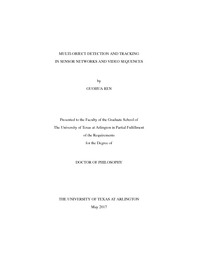
ATTENTION: The works hosted here are being migrated to a new repository that will consolidate resources, improve discoverability, and better show UTA's research impact on the global community. We will update authors as the migration progresses. Please see MavMatrix for more information.
Show simple item record
| dc.contributor.advisor | Schizas, Ioannis D. | |
| dc.creator | Ren, Guohua | |
| dc.date.accessioned | 2017-07-03T14:58:39Z | |
| dc.date.available | 2017-07-03T14:58:39Z | |
| dc.date.created | 2017-05 | |
| dc.date.issued | 2017-05-05 | |
| dc.date.submitted | May 2017 | |
| dc.identifier.uri | http://hdl.handle.net/10106/26796 | |
| dc.description.abstract | Firstly the problem of tracking multiple objects using observations acquired at spatially scattered sensors is considered here. Sensors are measuring a sort of signal attenuation from the present targets/sources. Multiple moving targets may die and be born at some point of the monitored period while the states of the sources, e.g. temperature of a fire source, CO/CO2 density of gas source, are also changing with time. In the case of targets tracking, radar signals sent out by sensors and later bounced back from the surface of the targets are measured at sensors, and the task is to find out the true position/velocity information hidden in the sensor measurements. While in the scenario where sources are present in the sensed field, the aforementioned signal attenuation is generally not available, so the task is to estimate the states of the corresponding sources and in the meanwhile recovering the unknown sensing observation matrix.
Concretely, in this thesis a framework is put forth where norm-one regularized factorization is employed to decompose the sensor observation data covariance matrix into sparse
factors whose support facilitates recovery of sensors that acquire informative measurements about the targets. This novel sensors-to-targets association scheme is integrated with particle filtering mechanisms to perform accurate tracking. Precisely, distributed optimization techniques are employed to associate targets with sensors, and Kalman/particle filtering is integrated to perform target tracking using only the sensors selected by the sparse decomposition scheme. Different from existing alternatives, the novel algorithm can efficiently track and associate targets with sensors even in noisy settings.
As for the multi-source tracking scenario, two different sensing architectures are studied: i) A fusion-center based topology where sensors have a limited power budget; and ii) an ad hoc architecture where sensors collaborate with neighboring nodes enabling in-network processing. A novel source-to-sensor association scheme and tracking is introduced
by enhancing the standard Kalman filtering minimization formulation with norm-one regularization terms. In the fusion-based topology a pertinent transmission power constraint is introduced, while coordinate descent techniques are employed to recover the unknown sparse observation matrix, select pertinent sensors and subsequently track the source states. In the ad hoc topology, the centralized minimization problem is written in a
separable way and the alternating direction method of multipliers is utilized to construct an in-network algorithmic tracking and association framework.
The problem of distributed tracking of multiple targets is tackled by exploiting sensor mobility and the presence of sparsity in the sensor data covariance matrix. Sparse matrix
decomposition relying on norm-one/two regularization is integrated with a kinematic
framework to identify informative sensors, associate them with the targets and enable them to follow closely the moving targets. Coordinate descent techniques are employed to determine in a distributed way the target-informative sensors, while the modified barrier method is employed to minimize proper error covariance matrices acquired by extended Kalman filtering. Different from existing approaches which force all sensors to move, here local updating recursive rules are obtained only for the target-informative sensors that can update
their location and follow closely the corresponding targets while staying connected.
Lastly, we extend out tracking scheme to tackle the problem of tracking multiple objects in a sequence of frames (video). The task of identifying objects is formulated as the process of factorizing a properly defined kernel covariance matrix into sparse factors.
The support of these factors will point to the indices of the pixels that form each object. A coordinate descent approach is utilized to determine the sparse factors, and extract the object pixels. A centroid pixel is estimated for each object which is subsequently tracked via Kalman filtering. A novel interplay between the sparse kernel covariance factorization scheme along with Kalman filtering is proposed to enable joint object detection and tracking, while a divide and conquer strategy is put forth to reduce computational complexity and enable real-time tracking. Extensive numerical tests on both synthetic data and thermal video sequences demonstrate the effectiveness of the novel approach and superior tracking performance compared to existing alternatives. | |
| dc.format.mimetype | application/pdf | |
| dc.subject | Sensor networks | |
| dc.subject | Multi-object tracking | |
| dc.subject | Sparse decomposition | |
| dc.subject | Thermal videos | |
| dc.title | MULTI-OBJECT DETECTION AND TRACKING IN SENSOR NETWORKS AND VIDEO SEQUENCES | |
| dc.type | Thesis | |
| dc.degree.department | Electrical Engineering | |
| dc.degree.name | Doctor of Philosophy in Electrical Engineering | |
| dc.date.updated | 2017-07-03T15:00:46Z | |
| thesis.degree.department | Electrical Engineering | |
| thesis.degree.grantor | The University of Texas at Arlington | |
| thesis.degree.level | Doctoral | |
| thesis.degree.name | Doctor of Philosophy in Electrical Engineering | |
| dc.type.material | text | |
Files in this item
- Name:
- REN-DISSERTATION-2017.pdf
- Size:
- 1.834Mb
- Format:
- PDF
This item appears in the following Collection(s)
Show simple item record


